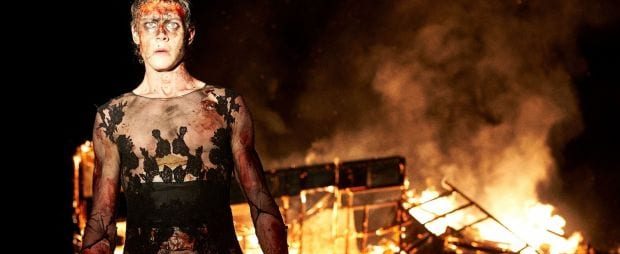Photograph: Transmission Films
We wear clothes almost all the time. We have deliberately chosen to wear those flared jeans or that structured jacket. Even the fashion phobic curate their wardrobes, even if they just throw away holey socks. And yet, costume design in cinema is often considered frivolous.
Almost every awards season, only costumes from period films or fantasy and science fiction films are nominated. The purpose of costuming shouldn’t just be to provide us with a feast for the eyes. The small details of a rolled-up cuff or a pressed shirt subliminally tell us something about a character. Even if we’re not aware of it, costume design is paramount in enveloping us in a film’s world. True History of the Kelly Gang wasn’t mentioned when the Costume Designers Guild announced their nominees for their awards ceremony last week, yet the costumes designed by Alice Babidge illustrate perfectly how the characters ricochet between the masculine and feminine sides of their personalities as they struggle with gender expression.
Justin Kurzel’s film is the latest rendition of Australia’s first folk hero and famed outlaw, Ned Kelly, played here by George MacKay. Set in the Australian bush in the 1870s, Kelly is situated as wheeling towards his historic death from the first beats of the film. While the story of the murderer and outlaw might be familiar, True History of the Kelly Gang immediately establishes that “nothing you’re about to see is true”. As such, the film and its costuming are wonderfully ahistorical. It leaves the stuffy air of a period drama behind to explore serious issues like gender roles, performance and toxic masculinity.
Trees rise up from this rural landscape like daggers, but the outlaws stalk these woods bedecked in ruffles, lace and organza. The female characters slouch in dungarees and button-down dresses, but the men wear haute couture gowns even when they carry out vengeful murder. Allegedly, this is the 19th century, but the traditional gender roles are turned on their head. The Kelly gang wear dresses to foster the element of surprise, with Dan Kelly (Earl Cave) commenting that “men are most afraid of what they don’t understand”, yet the costuming never wanders into comic cross-dressing territory. These boys aren’t Jack Lemmon and Tony Curtis in Some Like It Hot, fussing with their fostered garb, awkwardly pretending to be women. Instead, Babidge has taken a leaf out of Harry Styles’ book. There’s nothing so fierce as George MacKay, his face smeared with black mud and fingers stained with ink, sneering over his hostages while dressed in a black, gauzy lace number, reminiscent of Elie Saab’s runway collections. Yet, for all of Ned’s violence, he isn’t as masculine as he pretends to be. His relationship with Mary (Thomasin McKenzie) is deliberately undeveloped, while his relationship with Joe Byrne (Sean Keenan) is a little more than brotherly. And while nothing is explicitly said, Babidge’s costumes do all the talking.
The costumes may break and snap the fragile rules of gender, but Babidge is careful never to make the world feel artificial and cheap. While there’s little that remains from the Victorian era in the folds of skirts and heeled boots, all the costumes are made from natural materials, from lace to organza to silk. A material like polyester would have been instantly recognisable even to the untrained eye. From Ned’s woollen blood-red shirt to Mary’s blue organza gown, the costumes feel grounded even though no period nor colour scheme really connects them. There’s a sincerity in how these costumes comment on gender, and anything vaguely cheap-looking could have easily made a mockery of the boys’ feminine disguises.
While the costumes have abandoned the nineteenth century, the clothes have quietly embraced the rockstar motifs from the 60s and 70s. The outfits that Ned Kelly’s mother, Ellen (Essie Davis), wears feel rough and lived in. She wears stacked rings and dresses folded around her waist. She’s a woman who’s willing to sell her son to the outlaw Harry Power (Russell Crowe), and all that matters to her is survival. From the floral prints to the cropped jackets, her outfits suggest that at her core, she is a rebellious, wild woman, a Victorian sister of Janis Joplin. Ned returns as a man to his mother’s outback shack, and he wears a tight khaki jacket that has a whiff of hypnotic popstar power. It’s not only the cross-dressing that screams the desperate performative nature of Ned Kelly, but it is in every second of the screenplay. This is a man who acts out the harsh sides of his masculinity but he’s also a showman, known for theatrics. This is a story told to Ned’s unborn child and is one that is separated into neat acts. This film may be a fictionalised retelling of Ned Kelly, but even in each stitch, there’s a nod at the performative and mythical man that has been sewn in Australia’s history as a legend.
True History of the Kelly Gang isn’t likely to win any awards for its costuming this season. But costume design can be so much more than beautiful dresses or an impression of the past. By letting go of the idea of a pristine costume drama, Alice Babridge’s costume design prompts intriguing conversations on masculinity and gender performance.
Words by Lucy Clarke
Support The Indiependent
We’re trying to raise £200 a month to help cover our operational costs. This includes our ‘Writer of the Month’ awards, where we recognise the amazing work produced by our contributor team. If you’ve enjoyed reading our site, we’d really appreciate it if you could donate to The Indiependent. Whether you can give £1 or £10, you’d be making a huge difference to our small team.
